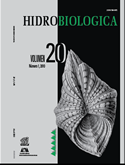Relative viable fecundity in the red lobster Panulirus interruptus (Randall, 1840) in Baja California, Mexico
Keywords:
Panulirus interruptus, Relative Viable Fecundity.Abstract
The fundamental objective of this work is to estimate the Relative Viable Fecundity as the number of phylosomes born alive during hatching of the spawn, per longitude of the cephalothorax per female, of Panulirus interruptus in Baja California, Mexico, under laboratory conditions, with goals for its application on the culturing of the specie. The zones of origin of the spawning females were: Bahía Todos Santos, Punta Baja and Isla de Cedros, Baja California, México. From the females between 62.097.2 Lc (mm), an average of 224,402 live phylosomes were obtained up to 3 days after hatching. The Relative Viable Fecundity resulted between 900.16,922.8 phylosomes/Lc (mm), with a mean of 2 795 phylosomes/Lc (mm). The relationship between the cephalothorax length (mm) and the number of phylosomes resulted: Phylosomes = 0.0083 Lc (mm)3.9046; r2 = 0.615. The Relative Viable Fecundity estimated for this work resulted greater than that currently reported in the literature for Jasus edwardsii.Downloads
Downloads
Published
How to Cite
Issue
Section
License
Los autores/as que publiquen en esta revista aceptan las siguientes condiciones:
De acuerdo con la legislación de derechos de autor, HIDROBIOLÓGICA reconoce y respeta el derecho moral de los autores, así como la titularidad del derecho patrimonial, el cual será cedido a la revista para su difusión en acceso abierto.
Publicar en la revista HIDROBIOLÓGICA tiene un costo de recuperación de $500 pesos mexicanos por página en blanco y negro (aproximadamente 29 dólares americanos) y $1000 pesos por página a color (aproximadamente 58 dólares americanos).
Todos los textos publicados por HIDROBIOLÓGICA sin excepción se distribuyen amparados bajo la licencia Creative Commons 4.0Atribución-No Comercial (CC BY-NC 4.0 Internacional), que permite a terceros utilizar lo publicado siempre que mencionen la autoría del trabajo y a la primera publicación en esta revista.
Los autores/as pueden realizar otros acuerdos contractuales independientes y adicionales para la distribución no exclusiva de la versión del artículo publicado en HIDROBIOLÓGICA (por ejemplo incluirlo en un repositorio institucional o publicarlo en un libro) siempre que indiquen claramente que el trabajo se publicó por primera vez en HIDROBIOLÓGICA.
Para todo lo anterior, el o los autor(es) deben remitir el formato de Carta-Cesión de la Propiedad de los Derechos de la primera publicación debidamente requisitado y firmado por el autor(es). Este formato se puede enviar por correo electrónico en archivo pdf al correo: enlacerebvistahidrobiológica@gmail.com; rehb@xanum.uam.mx (Carta-Cesión de Propiedad de Derechos de Autor).
Esta obra está bajo una licencia de Creative Commons Reconocimiento-No Comercial 4.0 Internacional.


